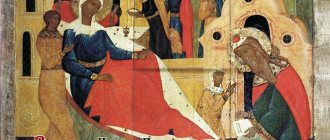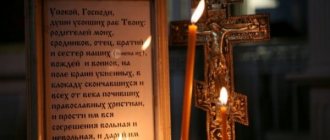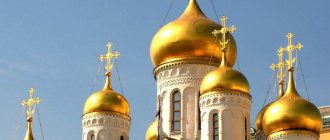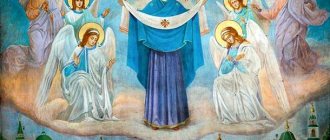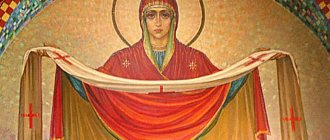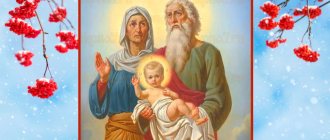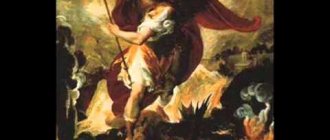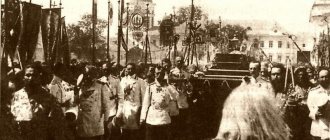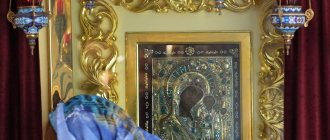History of the celebration
According to Tradition, the Virgin Mary was born in Jerusalem.
But in the Russian Orthodox Church there is a widespread version, which was universally adhered to by Saint Demetrius of Rostov, that Her birth into the world of God happened in Nazareth, where her parents Joachim and Anna lived.
Birth of the Virgin Mary
So... North of Jerusalem in the mountainous region near the Ezdrelon Valley lay the small town of Nazareth. This city, like its inhabitants, was not famous for anything significant, so there was an opinion among the Jews that nothing good could come from Nazareth.
But a married couple lived in this town; it was them who God chose to be the parents of the Mother of the Savior of the World. Coming from a royal family and the daughter of a high priest, Joachim and Anna were wealthy people, had wealth, servants and a household. But this did not prevent them from treating each other reverently, leading a God-fearing life, and showing acts of mercy. For these qualities, the townspeople loved the pious Christian family very much.
Other Christmas holidays:
- Nativity of John the Baptist
- Divine service for Christmas
But the spouses were very depressed by the absence of children, and in those days it was a sign of God’s punishment (wrath). But the couple did not complain, they constantly begged for the gift of joy in life in the form of a long-awaited baby, although in their advanced years the birth of a child, in principle, was no longer possible.
The Virgin Mary and her parents
Angel's Message
One day Joachim withdrew into the desert to pray intensely and keep a strict fast. The righteous wife, recognizing the guilt of childlessness, grieved greatly and began to pray even more fervently to God for the gift of a child. And then a miracle happened - an Angel of the Lord descended from Heaven and announced to her that the prayer had been heard by the Creator and that a conception would soon take place, from which a daughter would be born into the family, blessed, above all earthly daughters, and ordered her to be named Maria.
The same Angel appeared to Joachim. He announced to him the imminent birth of his daughter. In response, the righteous husband promised that if it happened that Anna gave birth to a daughter, he would certainly give her to serve God.
The righteous man headed to Jerusalem, where Anna was waiting for him at the golden gates, and together they returned to Nazareth. And after the expiration of the pregnancy, the woman gave birth to a daughter, whom the parents named Mary, as the Angel ordered.
Joachim arranged a grand feast, to which many people were convened. During the feast, the father raised his daughter and asked the priests to bless her.
Nativity of the Virgin Mary. Fresco by Giotto
Divine service
In honor of the Nativity of the Virgin Mary, a festive service is held in churches on September 21. During the Liturgy, the troparion, kontakion, dignification and magnification are read. For the holiday, all clergy prepare festive sermons in which they talk about the miracle of the birth of the Virgin Mary. The Almighty gave the daughter Mary to elderly and barren parents. This woman later became the mother of the Son of God, who saved humanity from the Fall.
Canon
In the morning at the festive service, an entire solemn poem consisting of nine songs is read. Each hymn consists of an irmos (initial stanza) and several troparion stanzas glorifying the Mother of God. The entire text of the festive canon is dedicated to the Nativity of Mary and the glorification of the Mother of God. The songs ask to confirm believers in the faith and send them forgiveness of sins.
Song 1
Irmos: Come, O people, let us sing a song to Christ God, who parted the sea and taught the people, even as He brought forth from the work of the Egyptians, as if He were glorified.
Come, faithful ones, rejoicing in the Divine Spirit, Even from this barren day we will honor the Ever-Virgin Lady who came to save people with songs.
Rejoice, Pure One, Mother and Servant of Christ God, Even the first Intercessor of bliss, the human race, we all worthily glorify Thee with songs.
Today a bridge is born of life, whereby men glorify Christ the Giver of Life with songs, the cry of the fall, which was found from hell.
Song 3
Irmos: Establish us in You, Lord, the Tree that kills sin, and plant Your fear in the hearts of us who sing of You.
You lived immaculately to God, begetting Salvation of all, God-wisdom parent of the Creator of the Birth and our God.
The Lord, who exuded life to all, from barrenness, gave birth to the Virgin, who willed to dwell in Nyuzha, and after Christmas, preserving the incorruptibility.
Anna's fruit, Mary, today, who gave birth to the life-giving grape, as we sing to the Mother of God, the Representative of all and the Helper.
Sedalen, voice 4
The Virgin Mary and Mother of God truly, like a cloud of light, will rise to us today and will come from the righteous to our glory. Adam is not condemned to anyone, and Eve is freed from her bonds, and for this reason we cry out loudly with boldness to the One Pure Ones: joy proclaims Your Nativity to the whole universe.
Song 4
Irmos: Hear the Lord, hear Your gaze and glorify You, the One Lover of Mankind.
We sing praises to You, Lord, who has given the faithful a saving refuge to all, Who gave birth to You.
You are the bride of God, show Christ praise and power to all who sing Your sacrament faithfully.
Unartful Lady, with Your prayers we deliver from sins, we prudently please You all.
Song 5
Irmos: The hay-written darkness of fortune-telling has destroyed and the faithful with the arrival of the truth, the Virgin Mary, illuminating the hearts, and instruct us with Your light, Christ.
Let us sing to the people of all the guilt of being guilty of us: Even though the prophets rejoice in this image, the revealed salvation from Him is fruitful.
From the dry vegetation of the priest's rod, Israel was shown insight, and now the lightness of the vegetated shines gloriously, from the barrenness an all-glorious birth.
Song 6
Irmos: Jonah cried out to the Lord from the whale: You raise me up from the depths of hell, I pray, so that as a Deliverer, with a voice of praise, I will devour the truth in the Spirit.
To the Lord, in the sorrow of barrenness, the parents cried out to the Mother of God of Godly wisdom, and to this mother from generation to generation, for common salvation and praise.
I have received the Heavenly gift from God, worthy of the Mother of God, the parents of the Divine Wisdom, the samekh of the Cherubim who carried more than the Word, the Mother of God and the Creator.
Kontakion, voice 4
Joachim and Anna were reproached by childlessness, and Adam and Eve were freed from the aphids of death, O Most Pure One, in Thy holy Nativity. Then Thy people also celebrate, having been freed from the guilt of sins, always calling upon Ty: the Mother of God and the Nourisher of our life bears barren fruits.
Ikos
The prayer and sighing of the barrenness and desperation of Joachim and Anna are favorable and in the ears of the Lord below, and the fruit of the vegetative life is life-giving to the world. She prays in the mountain, and she bears reproach in the garden, but with the joy of barrenness she gives birth to the Mother of God and the Nourisher of our life.
Song 7
Irmos: The bush in the mountain, the fire-scorching one, and the dew-bearing cave of the Chaldeans, has ordained You, the Bride of God, the Divine One, the Immaterial One in the material womb. You have received the fire without burning. Moreover, from You we sing: Blessed are You, God our Father.
Your lawmaker is forbidden to understand in material phenomena the great, Most Pure, mystery; not to be wise, earthly and zealous is figuratively punished sometimes. Moreover, I was amazed at the miracles, saying: Blessed be God our father.
The mountain and the door of heaven and the mental ladder of the divine face of the pronunciation of God, for from you the stone was cut off not by the hands of men, and the door, through which the Lord passed, who is the God of miracles ours.
Song 8
Irmos: In the cave of adolescence you sometimes represented Your Mother, O Lord, and this image is taken from the fire of the unburned One who came in, and we sing of You, who is the end of the day, and we extol to all eyelids.
Even to the God of our reconciliation the predestinated tabernacle even now begins to be, having given birth to the Word, to us the foolishness of the Flesh appears, Whom we eat, from those who do not exist in the hedgehog. moss, and we exalt to all ages.
Resolve the infertility of the worldly good, and clearly show the miracle of Christ, having come to the earthly, Him we eat, from those who do not exist, we receive Him, and exalt Him to all ages.
Song 9
Irmos: Even before the Sun, the Lamp of God, who arose, came to us carnally, from the side of the Maiden indescribably embodied, Blessed All-Pure, We magnify You, Mother of God.
Who has poured out water from stones to disobedient people, and with a submissive tongue bestows fruit from barren loins for our joy, You, Most Pure Mother of God, we deserve to magnify.
In vain is the ancient remover of condemnation and the foremother of correction, just as the generation was taken to God, to the Creator of the bridge, we magnify Thee, the Mother of God.
Luminous
From the barren day of Anna came forth, O Mother of God, all the incense of the Divine, fulfilling the ends of the world, and filling all creation with joy, Who sings, we worthily praise, as I exist on earth exceeded relatives.
Kontakion
The holiday kontakion says that Joachim and Anna atoned for their childlessness by giving the world the Mother of God. The mercy of the Almighty, who once saved Adam and Eve from corruption, descended on the couple. Mary gave birth to the Savior, who atoned for the sin of people at the cost of her own life. Barren Anna gave the world the Mother of God and, together with her husband Joachim, received the immortality of the soul.
“Joachim and Anna suffered the reproach of childlessness, and Adam and Eve were freed from mortal aphids, O Most Pure One, in Thy holy Nativity. Then Thy people also celebrate, having been freed from the guilt of sins, and always call upon Thy: infertility gives birth to the Mother of God and the nourisher of our life.
Joachim and Anna were freed from reproach for childlessness, and Adam and Eve were freed from death by Your holy Birth, Most Pure One. It is also celebrated by Your people, who have been delivered from the burden of sin, loudly exclaiming to You: the barren gives birth to the Mother of God and the nourisher of our Life.”
The meaning of the holiday
It was at a time when the world was experiencing a severe decline in moral values and there was a great need for a revival of faith that the Blessed Virgin was born. It was She who was chosen by the Creator to be the most worthy of the worthy in order to be the Mother of God and reveal to the world in the form of human nature the Son of God.
About other Mother of God holidays:
- Annunciation
- Dormition
- Introduction to the Temple
The birth of Mary brought the earthly world closer to the Kingdom of God, to the knowledge of truth and eternal life in Christ. And the Mother of God Herself was destined to be the merciful Intercessor of Orthodox Christians.
Old Testament, Gospel, Church Tradition
The Nativity of our Most Holy Lady Theotokos and Ever-Virgin Mary is the first twelfth holiday. The first is both according to the chronology of the events of Sacred History, which are remembered during the holidays, and according to the day of celebration in the church year, beginning on September 1 (14).
According to the teachings of the Church, the Nativity of the Blessed Virgin Mary is not a random event. She was assigned the most important role in the implementation of the plan for the salvation of mankind.
There are a number of Old Testament prophecies and types that are traditionally considered to indicate the birth of the Virgin Mary, such as, “The seed of the woman will blot out the head of the serpent” (Gen. 3:15). Or Jacob’s dream, in which, according to the Church, the Mother of God symbolically forms a ladder stretching to heaven, along which the Lord will descend. This is also Solomon's parable, beginning with the words: “Wisdom made for herself a house.” The house created by Wisdom is the Mother of God, who has become the dwelling of the hypostatic Wisdom, God the Word. In liturgical texts, the Mother of God is called the Temple of God, God's Dwelling Place. The Mother of God remains the purest and most perfect image of the Church.
The Prophet Moses, in a vision of a bush that burned in fire, but was not consumed (Exodus 8:1-5), was told at the Nativity of the Most Holy Theotokos: “for the bush is not scorched, so the Virgin gave birth and the Virgin abided” (dogmatist 5th voice). There are other indications in the Old Testament, which are, according to a number of theologians, an indication of the future event of the Nativity of the Virgin Mary.
However, the information about the earthly life of the Mother of God contained in the Holy Scriptures of the New Testament is not sufficiently detailed. There are only a few episodes testifying to the personality of the Virgin Mary (Mt 1. 16, 18-25; 2. 11, 13-15, 19-23; 12. 46-50; 13. 55; Mk 3. 31-35; Lk 1. 26-56; 2. 4-7, 16-52; 8. 19-21; John 2. 1-12; 19. 25-27; Acts 1. 14), however, we do not learn anything from the New Testament narrative about the circumstances of her Christmas, nor about the rest of her life.
All these details of the life of the Ever-Virgin Mary are brought to us by Church Tradition, that is, ancient legends, church historical works, as well as hymnographic liturgical heritage.
One of the original such (extra-biblical) sources are the early Christian apocrypha: “The Story of Jacob about the Birth of Mary” (otherwise – “Proto-Gospel of Jacob”; 2nd half - late 2nd century, Egypt), “Gospel of Childhood” (otherwise – “ The Gospel of Thomas"; 2nd century), "The Book of Joseph the Carpenter" (c. 400, Egypt), "St. John the Theologian's tale of the Dormition of the Holy Mother of God" (IV-V centuries).
The Church does not recognize the apocrypha as a source of doctrine, but recognizes the authenticity of a number of stories that are connected with the earthly life of the Mother of God. These apocryphal stories were subjected to significant editing and were cleared of the “gnostic element”, being consistent with the canonical testimonies about the Mother of God contained in the Four Gospels. Work on proofreading apocryphal materials has been going on for centuries. As a result, a single and internally consistent Tradition about the earthly life of the Mother of God was formed, and the main events of Her life were included in the liturgical annual circle of fixed holidays.
How to celebrate the Nativity of the Virgin Mary
Since the 6th century, believers have rushed to churches where solemn services are held. People glorify God and the day when the Lord gave the world, in the form of the Most Pure Virgin, hope for the coming of the Savior to the world.
Housewives baked bread with the letters “P” and “B”, which meant “Nativity of the Virgin Mary”. They were distributed to all family members, relatives, friends, and kept under the icon of Jesus Christ until the day of His Nativity. It was believed that by eating a piece of this bread with prayer, it was possible to be cured of all kinds of ailments.
In the Holy Land, Jerusalem and Nazareth become centers of pilgrimage during these holidays. A huge stream of believers flocks to shrines associated with the earthly life of the Queen of Heaven. People especially strive to visit the source of the Virgin Mary and the Church of the Annunciation of the Virgin Mary in Nazareth, the Greek Church of the Nativity of the Virgin Mary in Jerusalem. According to Tradition, it was built on the site where Mary’s parents’ house previously stood.
On this day, Heaven hears all the prayers of Orthodox Christians, so it is necessary to repent of sins, thank the Creator and prayerfully ask for the fulfillment of what is asked.
Important point! On the day of the Nativity of the Blessed Virgin Mary, you should not drink alcoholic beverages, meat or non-lenten foods. It's a fast day! Physical work is prohibited, quarrels and judgments are taboo. It is necessary to maintain spiritual purity, practice virtue, and help in word and deed.
Icon "Nativity of the Blessed Virgin Mary"
Old Believer churches
The Nativity of the Most Holy Theotokos, as a great holiday, has always been revered by Russian Old Believers. In honor of this event, Old Believer churches were even consecrated. For example, in the city of Orekhovo-Zuyevo, Moscow region in Russia, there is still a functioning Church of the Nativity of the Blessed Virgin Mary, built by Old Believers back in 1884. The ancient building is protected by law.
In the city of Vilkovo, Odessa region in Ukraine, there is a church founded in the 19th century in honor of the Nativity of the Virgin Mary, also built by Old Believers. Another ancient Old Believer temple, built in honor of the birth of the Immaculate Virgin, is in the village of Cherten, Kaluga region in Russia. True, the church is desolate and destroyed.
Holiday customs: what can and should be done on this day
- The Nativity of the Virgin Mary in the world is considered a women's holiday, when every lady should be revered as a continuator of the family.
- Childless women attend a festive service, after which they arrange a dinner and invite the poor to the table, so that after the meal they pray for the hostess, who dreams of giving her a baby. It is believed that the prayers of the Mother of God for the gift of children, offered precisely on the day of Her Nativity, have special power.
- Previously, this Mother of God holiday was considered the beginning of the new year. It was customary to light a torch and not extinguish it even at night. When the first one burned out, the next one was ignited and so on. In modern times, some believers adhere to this tradition: they constantly have a lamp burning near their icons, day and night.
- The Day of the Nativity of the Mother of God began the matchmaking countdown: from this day on, matchmakers were sent to the houses of unmarried girls. On this day it is also good to have a wedding - the family will always be under the Protection of the Queen of Heaven.
- From ancient times to the present day, there has been a tradition: women went to the reservoir early in the morning. It is believed that if a girl or woman washes her face before sunrise, the beauty of her face will remain until old age. Of course, there is something pagan in this, but there is no harm.
- From the week of Christmas, housewives removed onions from the beds, and before it began, it was necessary to remove all other crops from the fields. Villagers sowed fields with rye, and beekeepers prepared hives for wintering.
What can you ask from the Mother of God?
The Most Holy Theotokos is one of the most revered saints. People turn to it in various difficulties, and it doesn’t matter at all what kind of icon is in front of the person asking. She will hear and help, even if the requests are voiced not in prayer, but in ordinary conversation.
However, over the course of many centuries, traditions have been established about which icon one should turn to for a certain problem. There are stories when the Mother of God Herself appeared to the one asking and indicated which icon should be prayed to and where to look for it.
When praying for the health of the body and soul, they turn to the “Healer”, and also after completing any work, one must pray to the “Merciful” and “Kazan” Mother of God icons.
In case of cancer, they ask the “Vsetsaritsa” for recovery.
For success in studies, in exams, in dissertation work, they pray to the image of the Mother of God “Addition of mind.”
The Virgin Mary is also prayed for a strong marriage.
They pray to the Mother of God “Feodorovskaya” and “Helper in Childbirth” for a baby, an easy pregnancy and a successful birth.
The Mother of God also helps in getting rid of harmful addictions: drinking, drug addiction, gambling. The image of the Mother of God from the “Inexhaustible Chalice” icon will help with this,
“Helper of Sinners” or “Recovery of the Lost.”
They ask the icons “Education” and “Mammal” for strength and intelligence in raising a child.
Was the conception virgin?
The Church celebrates the conception of St. Anne on December 9, calling this event “glorious and holy.”
However, the Orthodox Church does not recognize this conception as immaculate, unlike the Catholic Church, which in the 19th century proclaimed the corresponding dogma of the “immaculate conception.” Let us note that Catholics do not proclaim the “semless conception” of the Blessed Virgin Mary. By “purity” we mean that the Virgin from the moment of conception was not subject to the consequences of original sin.
Among Catholics, objections were voiced against such a teaching, but in 1854, Pope Pius IX raised the opinion of the immaculate conception of the Virgin Mary to the level of dogma, without any basis for it - neither in the Holy Scriptures nor in the teaching of the Fathers of the Church.
The Orthodox Church recognizes only the birth of the Savior as immaculate. In addition, He was born miraculously - from the Holy Spirit and the Virgin Mary. The Nativity of the Most Holy Theotokos took place naturally and, although the Virgin Mary personally was sinless, She still had a nature damaged by ancestral sin, and therefore she herself was in need of atonement. According to Saint Ambrose of Milan, “of all those born of women, only one is completely holy: our Lord Jesus Christ, who, according to the special, new image of the virgin birth, did not experience earthly damage.”
In Orthodox theological literature there are many treatises directed against the idea of the immaculate conception of the Virgin Mary. For example, this is the opinion of the professor of the Kyiv Theological Academy, Archpriest I.M. Skvortsov regarding the event of the Nativity of the Blessed Virgin Mary: “The Gospel testifies that the Holy Spirit descended on the Holy Virgin and overshadowed Her, and as a result of this, what is born from Her is holy, completely pure, sinless . Is it therefore necessary that the Holy Virgin herself be born without blemish? Not due to the fact that She was holy from birth, but due to the descent of the Holy Spirit on Her*** (the phrase is not completed). Tradition testifies that the Mother of God needed preparation in the temple from the age of 3. Original sin could not develop in Her. Her upbringing at the temple and prayer cleansed her entire soul. The final consecration took place on the day of the Annunciation. But how could original sin be cleansed when atonement had not yet been accomplished? This is the mystery of the blessed Seed of the Woman, prepared from time immemorial. The grace of the Holy Spirit could place the entire being of the Mother of God at the moment of conception of the Son of God to such a height of humility and reverence that nothing humanly damaged was involved in the conception.”
After the Nativity of the Most Holy Theotokos, her already elderly parents made thanksgiving sacrifices to God for the gift given to them, and Anna, after the birth of her daughter, made a vow that the baby would not walk the earth until the parents brought Mary into the temple of the Lord. “...They from Him,” says Saint Gregory Palamas, “received the promise of Your birth and, acting well, You, promised to them, in turn promised Him...” When the future Mother of God reached the age of 3, Joachim and Anna, who had put off her dedication to God until that moment, decided that the time had come to bring Mary to the temple. According to legend, Mary’s entry into the temple was accompanied by a solemn procession; along the road to the temple stood young virgins with lighted lamps. “...Let Joachim and Anna rejoice, for holy fruit has come from them, luminous Mary, Divine light, and rejoices as they enter the temple...” (sedalen after the Polyeleos of the Service of the Entry).
Signs
September 21 is considered the day when autumn becomes its full-fledged mistress, and based on the weather, you can make a forecast for the future:
- if the day turns out to be sunny, it means that the sun will shine outside the window until the end of October, and if the sky is overcast, you can expect autumn cold weather with rain;
- if it rains in the morning, the next 40 days will be rainy;
- if the grass is covered with morning dew, then exactly a month later frost will take its place and the first frosts will set in, and if the sun rose early and dried the dew, the winter will be snowless.
All agricultural work had been completed by this time, and onion week had begun—the period of onion harvesting.
There are other signs on the birthday of the Blessed Virgin Mary that are not related to the weather.
It is believed that all babies born on September 21 will be healthy and happy, since the Virgin Mary herself will protect them from enemies, illnesses and misfortunes.
